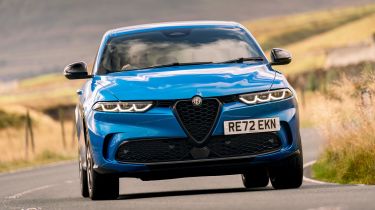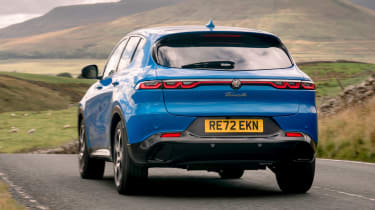Alfa Romeo Tonale review - Engines, performance and drive
The Tonale PHEV is comfortable, composed and packs plenty of punch, and as a result it’s our pick of the range

The Alfa Romeo Tonale lives up to its looks on the road. It might use the same basic underpinnings, and some of the same powertrain tech, from the Jeep Compass, but this is not a Jeep in a sharp Italian suit. The Tonale gets a bespoke suspension set-up with frequency-selective dampers that provide a great ride/handling balance that’s satisfying on a twisty road, yet comfortable enough when cruising.
The top-of-the-range Veloce trim adds adaptive dampers that can be controlled independently of the drive modes via a button in the middle of the ‘DNA’ rotary selector, so even if you’re in the sportier Dynamic setting, the bumpy road mode makes the ride noticeably softer.
The latter is a welcome addition as we found the default suspension mode for this set-up a little too firm for the average British B-road and can make the ride a little crashy on more broken-up surfaces, which isn’t particularly confidence-inspiring or comfortable. Plus, even in softer suspension settings, it’s not like the Tonale rolls to a significant degree when cornering quickly.
Sticking with the smaller wheels offered should improve the ride further. We’ve driven models fitted with 18- and 19-inch wheels and found both seem to generate quite a bit of road noise, with some wind noise infiltrating the cabin, too. Like Alfa’s Giulia saloon and Stelvio SUV, the steering is light and fast giving a lively feel on the road.
Used - available now

2025 Alfa Romeo
Tonale
15,739 milesAutomaticPetrol1.5L
Cash £23,995
2022 Alfa Romeo
Tonale
9,927 milesAutomaticPetrol1.5L
Cash £22,995Alfa Romeo’s familiar ‘DNA’ drive mode selector is present, but it's slightly different here. In Dynamic mode, the throttle, gearbox, stability control and steering are tuned to provide a more direct feel, and in the plug-in hybrid Tonale Q4, the brake regeneration gets stronger, too. Natural is the hybrid mode, which balances between performance and economy, while Advance Efficiency essentially puts the car into EV mode and dulls the throttle to eke out as much range as possible from the battery. There’s also a battery save mode in the plug-in model that lets you reserve charge for later in your journey.
The entry-level Tonale uses a mild-hybrid powertrain that combines a new 1.5-litre petrol engine with a small electric motor, however, the plug-in hybrid Tonale Q4 is our pick of the range. It feels more planted and less likely to be unsettled overall than the mild-hybrid version, and despite the extra weight of the PHEV model, which uses a 1.3-litre petrol engine, electric motor and 15.5kWh battery, it’s still keen to turn in and body control is kept in check.
Straight-line performance is stronger in the plug-in Tonale, too. The torque from the electric motor helps to push the back axle gently when accelerating out of a turn, though the Tonale still feels more front-driven than rear. The electric motor’s 121bhp is plenty for everyday driving and you can drive at up to 84mph on electric power alone in the Tonale PHEV, but it will comfortably cruise along the motorway with the engine just a distant hum at a little over 2,000rpm.
0-62mph acceleration and top speed
With 158bhp and 240Nm of torque on tap in the mild-hybrid Tonale, 0-62mph takes 8.8 seconds while the top speed stands at 131mph.
Performance is modest compared to the plug-in Tonale Q4, but the real let down is the power delivery. There’s a noticeable delay between you pressing the accelerator and the car actually responding. Not only does it suck some of the joy out of blasts along country roads, it’s a pain during regular driving, too, and means you’ll need to wait for bigger gaps when joining a roundabout or overtaking.
Opt for the plug-in hybrid Tonale Q4 with its more powerful petrol engine and electric motor, and power jumps up to 271bhp with over 400Nm of torque. This simultaneously slashes the 0-62mph sprint down to 6.2 seconds. Top speed is slightly lower though at 128mph.
The transition from electric to petrol power can be a bit clunky if you stamp on the throttle to join a motorway or overtake someone, but otherwise it’s pretty smooth and you’re never left floundering because the electric motor gives reasonable shove straight away. The weakest part of this powertrain is the laggy six-speed automatic gearbox.












